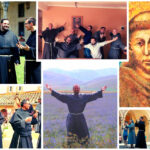9. The Idea of Going to the Infidels
Francis left his native Italy for the first time in 1212. He was driven by the desire to share the Good News, even with the infidels, even if it cost him his life. His destination was Syria. However, the ship he was on failed to reach that port and ended up on the Dalmatian coast due to a storm. He subsequently tried to reach the infidels in Morocco in 1214 or 1215, not by sea this time, but on foot, passing through nearby France and Spain. However, that journey also failed. This time, disease was the obstacle to his noble intention to preach in North Africa. Francis wanted to contribute to the conversion of Caliph Muhammad ibn Nasr. Unfortunately, he only got as far as the Iberian Peninsula before he was forced to return to Italy.
Despite the obstacles, he remained resolved and a few years later, in 1219, he tried again. Only this time, he changed direction and decided to go to the Holy Land. There, however, the conflict between Muslims and Christians had intensified because of the Crusaders. In spite of the dangers that awaited him, Francis managed to meet with Sultan Al-Malik al-Kāmil in person. Although Francis did not receive the palm of martyrdom, his bravery was undeniable—he was not even afraid to walk through fire before the Sultan. The meeting with the Sultan was an expression of profound courage; it had been accomplished during the full fury of the battle between the followers of Christ and Allah. Moreover, it was his fervent faith that inspired him to go to the enemy soldiers.
A contemporary of St. Francis, Jacques de Vitry, described this event: “When the Saracens captured him on the road, he said: ‘I am a Christian. Take me to your master.’ They dragged him before the Sultan. When that cruel beast saw Francis, he recognized him as a man of God and changed his attitude into one of gentleness, and for some days, he listened very attentively to Francis as he preached the faith of Christ to him and his followers. But ultimately, fearing that some of his soldiers would be converted to the Lord by the efficacy of his words and pass over to the Christian army, he ordered that Francis be returned to our camp with all reverence and security. At the end, he said to Francis: ‘Pray for me, that God may deign to reveal to me the law and the faith which is more pleasing to Him.’”
This visit to the Sultan shows very clearly that the Poverello of Assisi was very inspired by his desire to have an apostolate among the infidels. However, he did not use the terms “mission” or “missionary” because such concepts were foreign to his time and would not appear until the 16th century.
Friar Dariusz MAZUREK, General Delegate for Missionary Animation
Based upon:
Di Fonzo W., Odoardi J., Pompei A., Bracia Mniejsi Konwentualni. Historia i życie (1209-1976), Niepokalanów 1988.
Egger W., Lehmann L., Rotzetter A., Franciszek a misje, in: Duchowość franciszkańska, Wrocław 1992, zesz. 22.
Manselli R., Francisco de Asís entre conversión del mundo cristiano y conversión del mundo islámico. ¿Una relación atípica?, in: Para mejor conocer a san Francisco de Asís, Oñate (Guipúzcoa) 1997.
Manselli R., Święty Franciszek z Asyżu, Niepokalanów 1997.
Mazurek D., Św. Franciszek z Asyżu a misje wśród niewiernych, in: W Nurcie Franciszkańskim 8 (1999) 109-119.
For more information about missions, go to Facebook at:
https://www.facebook.com/AnimazioneFrancescana/
See also the Instagram account of the Mission Secretariat at:
https://www.instagram.com/sgam_ofmconv/














